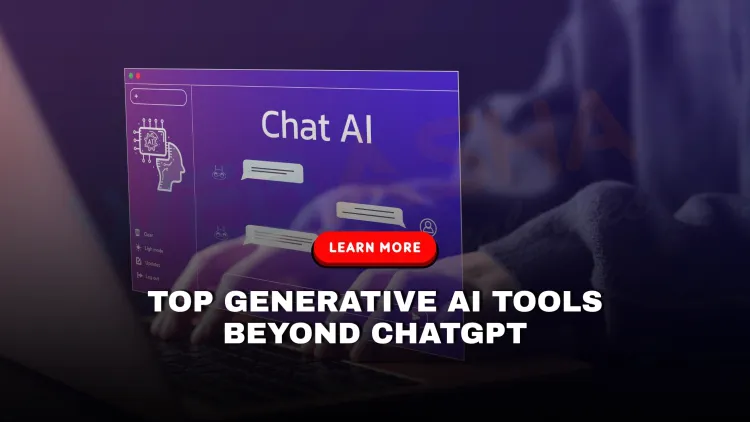What are the latest Generative AI tools beyond ChatGPT in 2025 and how are they transforming content creation, coding, and simulation?
Generative AI has rapidly evolved beyond ChatGPT, with powerful new models like Google Gemini, Anthropic Claude, and OpenAI’s Sora reshaping how we approach content creation, coding, and digital simulations. These next-gen tools use multimodal capabilities — including video, audio, and code generation — to automate complex tasks across industries. Whether it’s realistic video generation with Sora, ethical reasoning with Claude, or deep integrations of Gemini with Google's ecosystem, these models are changing how businesses and individuals interact with technology in 2025.

Table of Contents
- What Is Generative AI and Why Is It Evolving?
- Meet the Titans: ChatGPT, Sora, Gemini & Claude<
- How Generative AI Is Transforming Content Creation
- Impact on Coding and Software Development
- AI-Powered Simulation & Training (Sora’s Groundbreaking Leap)
- Ethical Considerations: The Deepfake & Hallucination Challenge
- The Future of Generative AI Platforms
- Who Should Use These Tools in 2025?
- Conclusion
- Frequently Asked Questions (FAQs)
Generative AI is no longer limited to just conversational models like ChatGPT. In 2025, it has evolved into a multi-modal powerhouse transforming the way we write, code, design, simulate, and even experience reality. Tools like OpenAI's Sora, Google's Gemini, and Anthropic's Claude are now shaping industries beyond chat — spanning video generation, code engineering, creative writing, simulation, and enterprise workflows.
In this blog, we explore how these next-gen generative AI platforms are changing the future — and how you can benefit from them.
What Is Generative AI and Why Is It Evolving?
Generative AI refers to algorithms and models that can create new content — such as text, images, code, video, music, and even synthetic speech — that mimics human-created output. Earlier models focused on natural language tasks. But 2025 has seen a surge in multi-modal systems that process and generate across text, image, video, code, and audio, enabling real-time simulation, automation, and decision-making.
The shift from "chat-only" AI to production-grade creativity engines is what’s powering the latest innovations.
Meet the Titans: ChatGPT, Sora, Gemini & Claude
| AI Model | Developer | Core Strengths | Key Use Cases |
|---|---|---|---|
| ChatGPT-4.5 | OpenAI | Conversational AI, reasoning, memory, plug-ins | Writing, research, education, personal assistants |
| Sora | OpenAI | Text-to-video generation, simulation | Film-making, training simulations, storytelling |
| Gemini 1.5 Pro | Google DeepMind | Multi-modal understanding, deep reasoning | Coding, document analysis, enterprise integration |
| Claude 3 Opus | Anthropic | Constitutional AI, context retention (up to 1M tokens) | Legal, ethical writing, long-form analysis |
These tools are not just answering questions—they’re shaping entire business pipelines, creative workflows, and automated simulations.
How Generative AI Is Transforming Content Creation
AI tools are now capable of writing compelling stories, generating images from text, editing videos, and composing music. Here’s how:
-
Sora can generate hyper-realistic videos from simple text prompts (e.g., “a drone flies over a snowy Tokyo street at night”).
-
Gemini is used in enterprise content automation, summarizing large PDFs, writing personalized emails, and generating product descriptions.
-
Claude 3 excels in structured writing, policy drafts, and handling long documents with minimal hallucination.
Real-world use case: A digital marketing agency uses Gemini and Sora together to create a full product video ad with script, voiceover, and animation — in under 10 minutes.
Impact on Coding and Software Development
Generative AI isn’t just about content. It’s also rewriting the way developers work:
-
Gemini 1.5 Pro integrates with IDEs like VS Code and Android Studio to auto-complete and debug multi-file projects.
-
ChatGPT with Code Interpreter & Python plug-ins can write and visualize algorithms instantly.
-
Claude 3 Opus can analyze 1000+ pages of documentation to answer how an API behaves.
Example: An engineer uses Claude to understand a legacy payment gateway’s documentation and build a new integration overnight — something that used to take days.
AI-Powered Simulation & Training (Sora’s Groundbreaking Leap)
Sora represents a quantum leap in how we use AI for simulation and learning:
-
Training Simulations: Generate realistic, interactive videos for emergency drills, military training, or flight simulation.
-
Healthcare: Visualize complex anatomy or surgical procedures based on descriptive inputs.
-
Education: Convert textbook paragraphs into dynamic short films to enhance comprehension.
By bridging text-to-video, Sora creates immersive digital realities — faster and cheaper than traditional production.
Ethical Considerations: The Deepfake & Hallucination Challenge
With great power comes great responsibility. These AI models can be misused for:
-
Deepfakes: Ultra-realistic fake videos, especially in politics or social manipulation.
-
Data bias: Reinforcing stereotypes or misinformation.
-
Hallucination: Incorrect responses that sound plausible.
Developers like OpenAI, Anthropic, and Google are working on AI alignment, safety layers, and watermarking technology to prevent misuse.
The Future of Generative AI Platforms
Looking ahead, expect:
-
Agent-like behavior: AI that can not only generate but act, schedule, analyze, and automate tasks across apps.
-
Real-time video generation + AR/VR integration.
-
Voice agents: Claude or ChatGPT-like systems integrated into operating systems (e.g., Android, Windows).
Generative AI is moving from “assistants” to co-creators and decision-makers in the workplace.
Who Should Use These Tools in 2025?
-
Developers: For faster prototyping, debugging, documentation, and testing.
-
Marketers: To auto-generate campaigns, creatives, and social ads.
-
Writers: For ideation, summaries, and content expansion.
-
Educators: For visual, AI-powered learning materials.
-
Businesses: For automation, simulations, and smart decision-making tools.
Conclusion
Generative AI tools like Sora, Gemini, and Claude have moved far beyond ChatGPT's original scope. These powerful platforms are changing how we think, work, create, and teach. Whether you’re an artist, engineer, teacher, or entrepreneur — integrating these tools could be your competitive edge in 2025.
FAQs
What is generative AI?
Generative AI refers to artificial intelligence models that can create new content such as text, images, audio, video, or code based on given inputs. It includes models like ChatGPT, Gemini, Claude, and Sora.
What is Google Gemini?
Google Gemini is a next-generation generative AI developed by Google DeepMind. It supports multimodal inputs and is deeply integrated with Google services like Docs, Sheets, and Android.
What is Sora by OpenAI?
Sora is OpenAI’s video generation model that can produce highly realistic, AI-generated videos from text prompts. It simulates real-world motion and scenarios.
How is Claude different from ChatGPT?
Claude, developed by Anthropic, emphasizes ethical AI with Constitutional AI architecture. It is designed for more thoughtful, safety-aligned conversations and content generation.
What makes generative AI different in 2025?
Generative AI in 2025 supports advanced multimodal capabilities, real-time simulation, better reasoning, and deep platform integration, making it more versatile and enterprise-ready.
Can Sora create full-length films?
While Sora can generate short video clips with complex scenes, it’s not yet fully capable of creating feature-length films but is progressing toward that direction.
Is generative AI used in software development?
Yes, tools like Gemini and ChatGPT are used for code generation, debugging, test automation, and even full-stack web development.
What industries are using generative AI the most?
Media, education, software development, marketing, finance, and healthcare are leading sectors leveraging generative AI.
Can Gemini integrate with Google Workspace?
Yes, Gemini integrates directly with Google Docs, Sheets, Slides, and more, offering AI writing, summarizing, and data analysis features.
Is Claude available for free?
Claude offers both free and paid versions depending on the user’s needs. Enterprise plans provide more access and API integration.
How secure are generative AI models?
Security varies by provider, but most leading models are designed with safeguards to prevent harmful content and misuse.
Does generative AI pose a risk to jobs?
Generative AI may automate repetitive tasks but also creates new opportunities in AI management, prompt engineering, and creative fields.
What is multimodal AI?
Multimodal AI can understand and generate content across different formats — like text, images, video, and audio — in a single interface.
Can ChatGPT generate video like Sora?
No, ChatGPT (as of 2025) is primarily text-based. Sora is OpenAI’s dedicated model for video generation.
What is Constitutional AI in Claude?
Constitutional AI is an approach used by Anthropic that aligns the model’s behavior with ethical principles defined in a set of rules or "constitution."
Are these AI models accessible to the public?
Yes, Gemini, Claude, and Sora offer varying levels of public access via web platforms, APIs, or partner integrations.
What’s the use of generative AI in marketing?
AI models generate content, analyze data, create visuals, and personalize customer messages in real-time, improving marketing efficiency.
How is simulation being transformed by AI?
Sora and similar models can simulate real-world environments, useful in gaming, training, education, and research.
Which AI is best for content creators?
Gemini and Claude are great for writers and creators needing structured content, while Sora is ideal for visual storytelling.
Are these AI tools ethical?
Leading AI platforms implement ethical guidelines, moderation, and safety protocols, though challenges around misuse still exist.
What’s the future of generative AI?
The future lies in hyper-realistic simulation, personalized AI agents, embedded AI in daily tools, and regulation for safe use.
Can these AIs work together?
Some platforms support API-level integration, allowing users to combine strengths of different AI tools in a single workflow.
Do I need coding skills to use generative AI?
No. Most tools like Gemini, Claude, and ChatGPT have user-friendly interfaces that don’t require coding knowledge.
What are the limitations of current generative AI?
Limitations include accuracy, hallucination, ethical bias, video length restrictions (in Sora), and dependence on training data.
Is there any AI that can generate games?
Experimental AI tools are emerging that can generate game logic, levels, or even entire simple games using text-to-code prompts.
What is the cost of using these models?
Pricing varies: Claude and ChatGPT offer free tiers; Gemini and Sora offer premium plans for advanced use and commercial deployment.
Can businesses build custom tools with these AIs?
Yes, APIs allow developers and businesses to build custom applications, assistants, and workflows using generative AI models.
How accurate are these tools?
They are highly accurate for many tasks but should be supervised when used in sensitive areas like healthcare or finance.
What’s the role of OpenAI’s Sora in education?
Sora can be used for immersive educational content, visual simulations, historical reenactments, and training environments.
Can Gemini generate code?
Yes, Gemini can write, explain, and optimize code across multiple programming languages using Google’s PaLM and Gemini models.
Where can I access these AI models?
You can access ChatGPT via OpenAI, Claude via Anthropic, Gemini via Google, and Sora via OpenAI’s platform (beta or enterprise access).














![Top 10 Ethical Hackers in the World [2025]](https://www.webasha.com/blog/uploads/images/202408/image_100x75_66c2f983c207b.webp)








